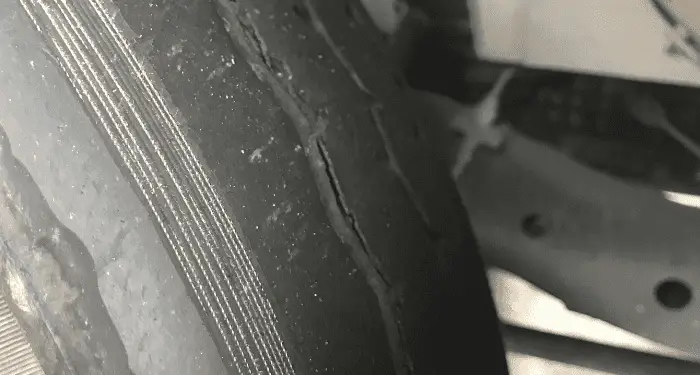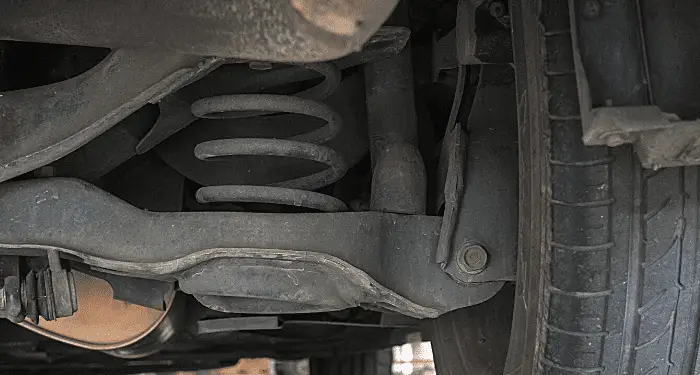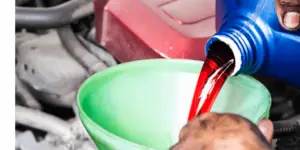In extreme scenarios, a bumpy ride can make you feel ill. For most people, though, it’s an inconvenience that might make us worry if there is a dangerous fault with our car.
Here we’ll examine the causes, costs, and fixes in some detail.
Briefly, though, the causes are likely to be. In order
- Tires and their balancing.
- Suspension
- Axles
- Transmission
Let’s get into the detail
1. Tires and Alignment
Your car is in contact with the road through your wheels and tires.
It’s where the rubber meets the road!
It’s only natural that these are the first things to check when your car seems to ride rough.
Unequal tire pressures over some tires or simply making a mistake when adding air can cause one of them not to cushion your ride as they should.
Furthermore, old tires can form cracks, lose their tire belts, start to disintegrate, lose their shape, or be generally stiffer.
Also, check for loose nuts, especially if you’ve just had a new tire fitted, as they can come loose.

There is also a possibility the rim itself has been damaged, especially off-road or in cars that drive miles on uneven roads or tracks.
If none of that is the case, it may be the alignment. A car pulling to one side when accelerating and uneven tire wear on the front tires are signs of bad alignment that exacerbate a rough rid.
Fixes:
Reinflate all the tires at the correct air pressure and check for punctures. Check your tires for obvious signs of wear and damage. If any are found, buy new tires as soon as possible.
Bent wheels can be refurbished depending on how bad the bend is, but often noticeable damage isn’t fixable.

If the tires and rims look okay, the wheel alignment might be off.
Bad alignment can also happen if you’ve got new tires fitted. Many garages offer this when fitting new tires, whereas tire balancing is always done. Alignment should be completed every two years and is different from wheel balancing.
Many visitors also read this article: Wheel Alignment Vs. Tire Balancing
2. Suspension
Your car suspension is the main component connecting your wheels to your car’s body. They provide a smooth ride and are responsible for the car’s handling.
Most of the time, the shocks and the struts are the suspension parts that fail and give a bumpy ride.
Signs of a damaged suspension are usually your car sounding bad and going over speed bumps or potholes. It can also be accompanied by the car leaning to one side, swaying to a side, bad absorption of bumps, or the car being jumpier than it used to be.
You may also feel jolts from the steering wheel when going over bumps or curbs and a knocking noise from the offending strut or shock.
Fixes:
Most of the time, shocks will crack and leak oil due to age or large impacts. They’re mostly replaced, as any repair is uneconomical and not worth the time.
Expect to pay between $120 and $300 for a new shock or strut. This includes the cost of fitting at a car shop. The price varies due to the make and model of the car.

3. Axles
The axle is the long rod that connects your wheels to the transmission. You have two of these, one for the back wheels and one for the front.
When they go bad, you’ll feel these wobbles at low speeds, and they’ll get bumpier as you accelerate.
Axles get bent when rocks or other objects get run over and smash into them.
In truth, the event would have been so noisy you’d have known something bad had happened.
Fixes:
A bent axle can be pushed back into shape if the bend is minimal.
If not, the whole axle would need to be replaced by a skilled mechanic or a competent DIY’er mechanic with a good set of tools.
A brand new axles cost between $300 and $500. This figure depends on whether the drive axle needs replacing and the make and model of the car. The part costs between $130 and $300, and labor costs are $170 to $200.
4. Transmission, Clutch, and Torque Converter
A transmission issue can set you back anywhere from $100 to as much as the cost of a used car.
One thing to check first is for a transmission fluid leak. Low fluid can also cause the transmission symptoms we will discuss here.
Transmissions are complicated pieces of engineering.
Many visitors also read this article: Why Does My Car Roll In Park? (SOLVED)
A transmission issue is usually very noticeable and accompanied by slow gear changes, loss of power, and the car not shifting or slipping out of gear.
These issues can also be accompanied by some whining or grinding noises. The car may jerk forward or back, feel bumpy or even be rough only in reverse gear.

Transmission is made of different cogs rotating; either can lose their teeth and be less grabby. There are also clutch and torque converters that can go bad.
A clutch on a manual car is a component that connects your transmission to the engine. It’s an item that will wear over time naturally. However, new drivers tend to keep their foot on this and rev the engine, thus wearing it out sooner.
If the clutch fails, your car may also jerk as it instantly grabs or loses contact with the engine or trans. It is worse when cold and is noticeable when you try to change gears. Often a wearing clutch will make metal grinding noises when cold.
If you have an automatic, next up is your torque converter. It performs the same task as the clutch on a manual car.
If the car shudders most at around 30-45 MPH, there’s a high chance your torque converter is on its way out. More symptoms of a bad torque converter are similar to the ones for clutch and transmission and work on similar principles.
Fixes:
First up, you should check the transmission fluid.
Without fluids, metal grinds together and doesn’t function well.
If that doesn’t fix it, you’ll need a specialist to take a look. Be warned; it can get expensive depending on what they find when they open the transmission.
Even if their issue was minor, the labor costs and time needed to inspect the transmission leads to a big bill.
My Car Rides Bumpy With New Tires?
Check out these four causes.
1. Wheels being improperly mounted. As discussed earlier, your wheels need to be firmly pushed against the disc and lug nuts accurately tightened.
Mechanics normally tell you to check the lugs are tightened after driving 100 miles after a tire replacement. They can work loose.
2. With new tires, your alignment numbers should change slightly. Newer tires(and wheels if you got different ones) may have different sizes, stiffness, heights, and grip than your older tires. Hence they’ll act differently with previous alignment settings.
Getting your car realigned is recommended by many manufacturers every time you get new tires- but it isn’t always done.
3. Tire pressures may be inaccurate for the new tires. This is rare, though, as it’s a basic new mechanic/tire fitter error.
4. Lastly, if all else fails, it just may be that your new tire is faulty. It does happen; it might be out of round. If they’ve not been driven much with, the place you bought them should inspect and replace them if they are found faulty.
In Conclusion
Bumpy rides can be caused by improper tire fitting, poor tire balancing, and inaccurate air pressure (too low, too high, or different pressures in each tire). The worst-case tire or wheel scenario may be that the rims have suffered damage or are bent.
Lesser causes are transmission and suspension problems.













